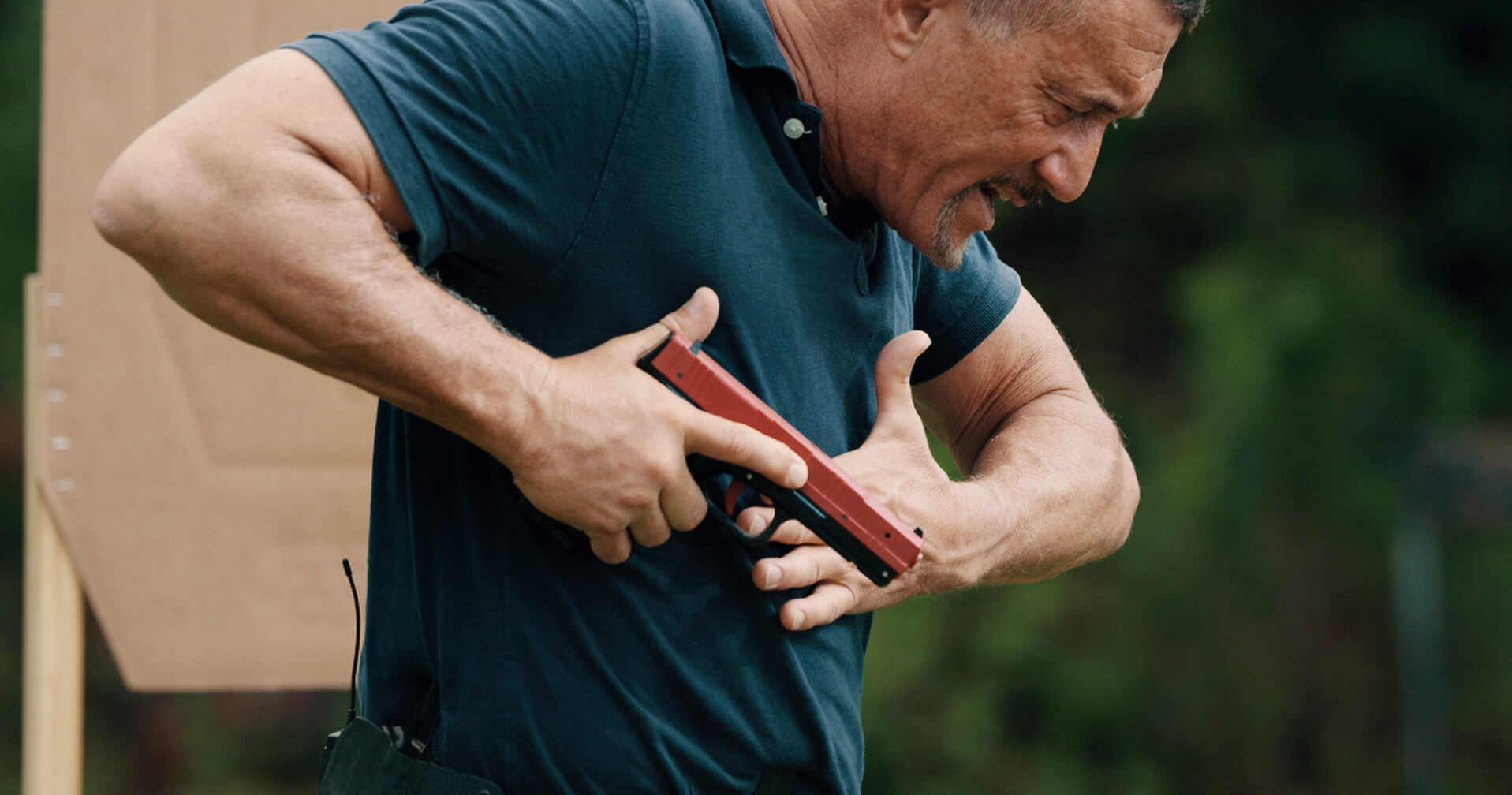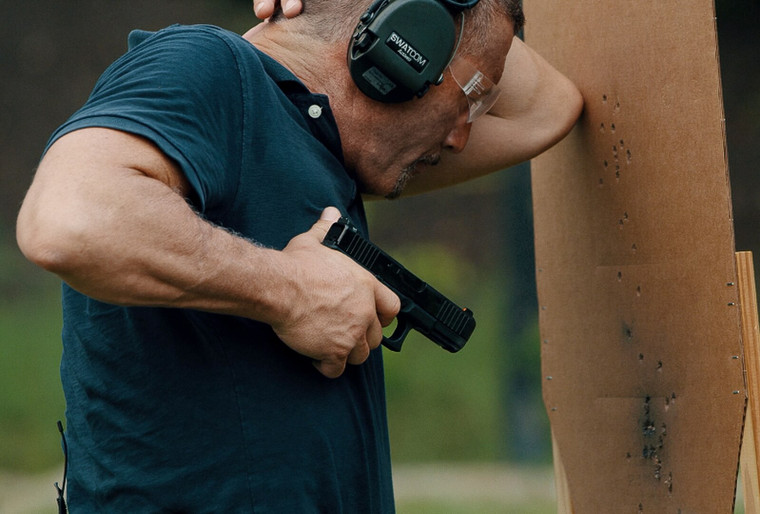When Your Enemy’s Close, Keep Your Gun Closer
Posted by Warrior Poet Society on Jan 31st 2024
Former Army Ranger, Narcotics Officer, and Jedi Master Craig Douglas teaches me (John Lovell) all about retention firing. This means how to handle my pistol when things get up close and personal with an attacker. Craig is also founder of Shivworks, making some of the best CQB blades on the market.
My good friend Craig Douglas and I spent a day at the range where he taught me the fundamentals of some more advanced skills in gunfighting, especially important when your attacker is already in your personal space. It’s a scary situation to be in, but there are some tools and drills for preparing so you have a fighting chance if the need arises.
He walked me through his Extreme Close Quarters Concepts course, because while I’m a skilled operator and can teach my skill set, dealing with a guy from three yards away (or less) is not my specialty. You’re trying to access a firearm while also defending against someone who could knock you out and take your weapon.
So, needless to say, this is not a beginner’s skill. Craig institutes some pretty stringent safety protocols to ensure no one gets hurt. We started with those inert orange plastic practice pistols to drill the movements before moving into live fire on cardboard dummies.
The Importance of Training Realistic Scenarios One of the key elements Craig likes to stress and train is the pressure of a real-life encounter. “A lot of what I saw trained in the past was not representative of what we saw on the streets. That’s why I started really examining this problem in 1998,” he said. “We started adding pressure and going after each other in these scenarios. A lot of the range-based training fell apart in those situations.”
This why we’d later test these skills back at the gym where I’d have to retain my orange pistol against some guys on the wrestling mat.

And of course while most of my day actually was spent on the range with Craig, the techniques he taught and drilled came from a bit of a “laboratory” he created.
“About three years of fight club where we pressure tested every possible permutation of where the gun should be [in a an ECQ scenario] so it would function well and get rounds off consistently and accurately into a person,” he said.
This is all supposed to happened without the slide catching on clothing or gear, without your hand or other appendages catching a bullet and so that the attacker is neutralized enough for full extension firing or other protective measures.
Here’s what I learned after a day of training.
How to Draw and Present the Gun for Gun Retention During ECQ
Thumb-Pectoral Index. If an attacker has entered your “wingspan,” meaning he’s up on you, you’re life is measured in milliseconds. Drawing and firing requires very precise and well-rehearsed movements. The Thumb-Pectoral Index is actually a lot like what it sounds like. The thumb of your firing hand is flared out as you draw, and you use that thumb to find your pectoral muscle. This ensures your at the right height with your gun and that the gun is far enough away from clothing and gear to ensure proper firing.
Your positioning so you can keep the fire arm far away from them, keep your non-active limb available for defense, and enabling you to fire from your arm pit down into their center of mass to create more distance.
A Good and Awkward Elbow Position. To ensure a straight, consistent line of fire in a pressured setting, you want to get your wrist and hand into a locked position. This will help your bullets go where you intend. This means your bent elbow is going to need to go sharply back and up, raising it uncomfortably to the level of your shoulder blade.
“I want you to jack that elbow as hard and as far back as you can,” Craig said. “If it feels really binding and uncomfortable, more than likely, you're doing this correctly.”
This will keep the gun stable and also will get the muzzle pointed downward, keeping it well away from the possibility of a round hitting your defensive hand or arm. "I've got my angle, I can hit him. I'm not going to send one off into the public. I'm not wondering whether I'm going to shoot myself in this mad tangle of limbs."
A key to drilling the various skills involved in ECQC is that whole “slow is smooth and smooth is fast” mantra you’ve probably heard about. Beginning with the orange guns, and drilling some repetitions with that turned to slow, methodical repetitions of life fire on the dummy. Each mechanical piece of the movements is done slowly until competence, then it speeds up.
But You’re Shooting Down?
“It’s about diminishment. You’re diminishing your chances of hitting off target and you’re diminishing his capacity, so you can exit the situation and get to your sights.”
Of course by “exit,” Craig means you’re at least able to create progressively greater distance, allowing for greater and greater presentation of your weapon until you’re far enough out for full presentation.
“If this guy still has any fight in him, probably the last thing I want to do in this moment is extend to my sights. So you’re stepping back with appropriate levels of extension.”
Where Do I Put My Other Hand?
“Now, the other thing I want you to be mindful of in these drills is of what's going on with your other hand.” It’s actually critical that your other hand actually have a purpose and a place. If it’s not being used to defend, keep it flat against your chest. In vertical elbow blocks, it’s tucked tightly behind your neck.
For horizontal elbow blocks, you’re using it to hug your own head. And when you’ve got the space to do so, you’re bring that hand to your pistol grip by moving it across your chest. “Make sure this hand is only collecting off the chest, always collecting behind the muzzle,” Craig said.
“There’ve been too many law enforcement officers who’ve shot their hand because they brought their hand out in front of the muzzle.” By drilling these rules in alignment with Craig’s precise, scientific breakdown of the biomechanics and disciplines, is that you are able to place shots at the same place consistently even when other variables and attackers are at play.
And none of those shots are shots from the hip, because you’re using those strict positionings and a view of your muzzle to ensure consistent hits every time, even while backing away to eventually get into a two-hand shooting position.
Train Hard. Train Smart. Live Free.

